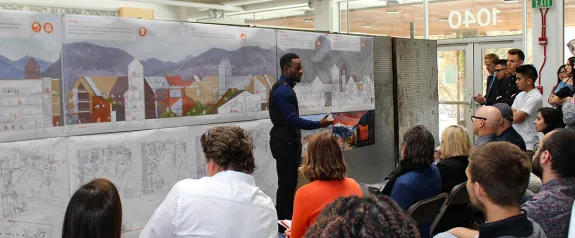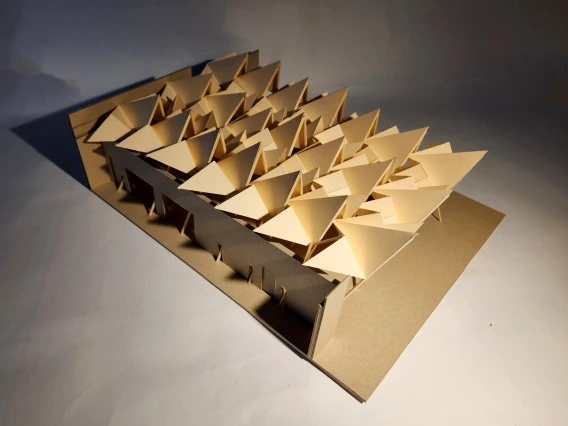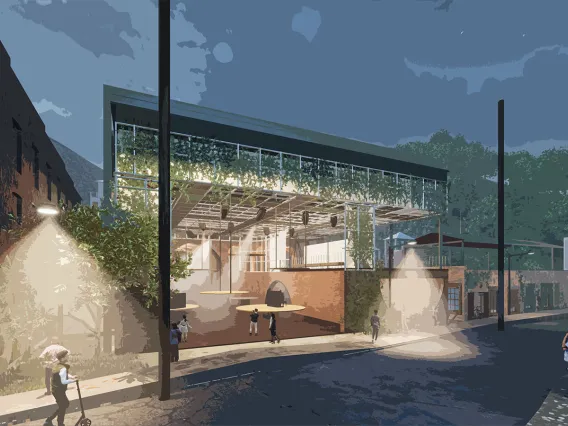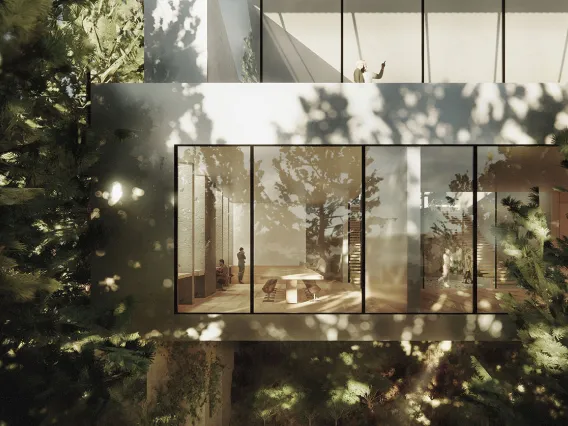
In the Bachelor of Architecture, you'll learn to design innovative spaces and places for complex social and environmental challenges of our time.
In the B. Arch program, we consider architecture to be the integration of the technical, historical, cultural, theoretical, and the experienced as a form-based and research-based practice. Your education here will be informed by place, materials, theories, and real-world problems of our time. Unlike four-year undergraduate architectural programs, the University of Arizona's five-year B.Arch program allows you to pursue professional registration without further academic study.
B.Arch Degree Stages
The Bachelor of Architecture is an accredited professional program in three stages: a Foundation, A Core, and a Reasearch and Innovation stage. Between the Foundation and Core stages, there is a milestone in which a portfolio of each candidate's work is assessed for advancement.
1. Foundation
In the Foundation Stage, the freshman year is devoted to basic design and representational skills (both handcraft and digital), an introduction to history and theory of the built environment and physical principles of buildings.
2. Milestone
Admission from Foundation to the Professional Stage is done via a Milestone, which certifies architectural aptitude. It comprises a portfolio review and grade calculation. Up to 90 qualified students are advanced to Core studies each year. More details on the Milestone can be found below in the curriculum dropdown.
3. Core
The 2.5-year professional Core Stage emphasizes individual skills and knowledge in five major areas: studio, history and theory, design communications, building technology and practice.
4. Research + Innovation
In the 1.5-year Research + Innovation Stage, students develop a research trajectory, take options studios to develop collaboration and complex design skills and ultimately demonstrate their individual visions in a year-long capstone project.
Curriculum
The five-year Bachelor of Architecture requires 166 units for graduation.
Review the Bachelor of Architecture curriculum by semester and year or view or download the B.Arch program overview and curriculum, which is divided by new students (those admitted for Spring 2022 and beyond) and students admitted prior to Spring 2022, due to updated general education course requirements:
Courses shown here indicate an ideal way to complete the B.Arch degree in five years. Some courses may be taken in sequence while others may be shifted in the student's plan of study. Please confer with your advisor.
B.Arch Curriculum for New Students
FALL 1
| Course # | Course Title | Units |
|---|---|---|
| ARC 101 A/B | Foundation Studio IA / Studio IB | 2/2 |
| ARC 131 A/B | Thinking About Architecture A / B | 1/1 |
| ENGL 101 | First-Year Composition | 3 |
| MATH 108 | Modeling with Algebraic and Trigonometric Functions | 4 |
| UNIV 101 | Introduction to the General Education Experience | 1 |
| TOTAL | 14 |
SPRING 1
| Course # | Course Title | Units |
|---|---|---|
| ARC 102 | Foundation Studio II | 4 |
| ARC 121 | Physical Principles of the Built Environment | 2 |
| ENGL 102 | First-Year Composition | 3 |
| General Education: Exploring Perspectives | 3 | |
| Second Language Semester 1 | 4 | |
| TOTAL | 16 |
^ Required coursework for continuation into Core Stage. ^
B.Arch Milestone
Admission from Foundation to the Professional Stage is done via a Milestone, which certifies architectural aptitude. It comprises a portfolio review and grade calculation. Up to 90 qualified students are advanced to Core studies each year.
The weighted criteria for the Milestone are:
- Portfolio: 25%. A portfolio of work from the Foundation studios, submitted at the completion of ARC 102.
- GPA: 15%. The student's University of Arizona cumulative GPA.
- Studio grades: 45%. The average of ARC 101A/B and ARC 102.
- History and Theory and Physical Principles Grades: 15%. In ARC 131A/B Thinking About Architecture, students are introduced to concepts, themes, precedents and movements throughout architectural history through lectures, journals and writing. In ARC 121 Physical Principles of the Built Environment, students study physics for architects using math, modeling and experimentation. The average grades from these courses is part of the Milestone score.
Students will be notified of advancement into the Core Stage as soon as grades are available, typically end of May for students who began in the fall and early August for students who began in the spring. Summer students can only be evaluated only after the formal receipt of grades.
A Notification of Acceptance form will be sent to students who pass the Milestone. It must be returned to the School of Architecture by the deadline to ensure acceptance into the Professional Stage.
FALL 2
| Course # | Course Title | Units |
|---|---|---|
| ARC 201 | Design Studio I* | 6 |
| ARC 221 | Building Construction I | 3 |
| ARC 231 | History and Theory of Architecture I | 3 |
| ARC 241 | Techne I | 3 |
| Second Semester Language 2 | 4 | |
| TOTAL | 19 |
SPRING 2
| Course # | Course Title | Units |
|---|---|---|
| ARC 202 | Design Studio II* | 6 |
| ARC 222 | Building Technologies I | 3 |
| ARC 232 | History and Theory of Architecture II | 3 |
| ARC 242 | Techne II | 3 |
| General Education: Exploring Perspectives | 3 | |
| TOTAL | 18 |
FALL 3
| Course # | Course Title | Units |
|---|---|---|
| ARC 301 | Design Studio III* | 6 |
| ARC 321 | Building Technologies II | 3 |
| ARC 326 | Practice I: Pre-Design | 3 |
| ARC 333 | History and Theory of Architecture III | 3 |
| ARC 341 | Techne III | 3 |
| TOTAL | 18 |
SPRING 3
| Course # | Course Title | Units |
|---|---|---|
| ARC 302 | Design Studio IV* | 6 |
| ARC 322 | Building Construction II | 3 |
| ARC 435 | Critical Inquiry and Expression | 3 |
| ARC 436 | Practice II: Ethics and Practice | 3 |
| General Education: Exploring Perspectives | 3 | |
| TOTAL | 18 |
FALL 4
| Course # | Course Title | Units |
|---|---|---|
| ARC 401 | Design Studio V* | 6 |
| ARC 421 | Building Technologies III | 3 |
| ARC 441 | Practice III | 3 |
| General Education: Exploring Perspectives | 3 | |
| TOTAL | 15 |
^ Required coursework for continuation into Research + Application Stage. ^
B.Arch R+I Group Selection
In the Research + Innovation Stage, students engage in design research by joining an R+I group that offers thematically related courses and culminates in a capstone project. R+I groups are comprised of faculty, staff and students devoted to a topical inquiry. Each group nurtures its students to develop capstone work of depth and excellence.
Each student is required to complete a cluster curriculum with at least four courses from a single R+I group:
Two R+I electives
- OR -
One R+I elective and one Options Studio (ARC 410E or ARC 410F)
- AND -
ARC 497 Project Inquiry and ARC 498 Capstone Studio
A cluster group may advance a larger number of R+I courses and each student is encouraged to develop a compelling individual plan of study that draws on these resources. Some R+I groups include a required 1-unit colloquium every semester in addition to the above requirements. Regardless of what is offered in any particular R+I group, students must complete all B.Arch requirements: two Options studios, 166 credit units, etc.
Students may take R+I courses that are not part of their group, for additional electives, provided there is capacity in the course. Members of group-specific R+I courses will have first enrollment priority.
SPRING 4
| Course # | Course Title | Units |
|---|---|---|
| ARC 410F | Options Design Studio* | 6 |
| R+I Elective | 3 | |
| R+I Elective | 3 | |
| General Education: Building Connections | 3 | |
| UArizona General Elective | 3 | |
| TOTAL | 18 |
FALL 5
| Course # | Course Title | Units |
|---|---|---|
| ARC 410F | Options Design Studio II* | 6 |
| ARC 497 | Project Inquiry* | 3 |
| R+I Elective | 3 | |
| General Education: Building Connections | 3 | |
| UNIV 301 | General Education Portfolio | 1 |
| TOTAL | 16 |
SPRING 5
| Course # | Course Title | Units |
|---|---|---|
| ARC 498 | Capstone Studio* | 6 |
| R+I Elective | 3 | |
| General Education: Building Connections | 3 | |
| UArizona General Elective | 3 | |
| TOTAL | 15 |
* Course requires a grade of C or higher to proceed to the next course.
Second-semester second language proficiency required for degree completion.
B.Arch Curriculum for Students Admitted Prior to Spring 2022
FALL 1
| Course # | Course Title | Units |
|---|---|---|
| ARC 101 A/B | Foundation Studio IA / Studio IB | 2/2 |
| ARC 131 A/B | Thinking About Architecture A / B | 1/1 |
| ENGL 101 | First-Year Composition | 3 |
| MATH 108 | Modeling with Algebraic and Trigonometric Functions | 4 |
| Second Language Semester 1 | 4 | |
| TOTAL | 17 |
SPRING 1
| Course # | Course Title | Units |
|---|---|---|
| ARC 102 | Foundation Studio II | 4 |
| ARC 121 | Physical Principles of the Built Environment | 2 |
| ENGL 102 | First-Year Composition | 3 |
| General Education Tier 1 | 3 | |
| Second Language Semester 2 | 4 | |
| TOTAL | 16 |
^ Required coursework for continuation into Core Phase. ^
B.Arch Milestone
Admission from Foundation to the Professional Phase is done via a Milestone, which certifies architectural aptitude. It comprises a portfolio review and grade calculation. Up to 90 qualified students are advanced to Core studies each year.
The weighted criteria for the Milestone are:
- Portfolio: 25%. A portfolio of work from the Foundation studios, submitted at the completion of ARC 102.
- GPA: 15%. The student's University of Arizona cumulative GPA.
- Studio grades: 45%. The average of ARC 101A/B and ARC 102.
- History and Theory and Physical Principles Grades: 15%. In ARC 131A/B Thinking About Architecture, students are introduced to concepts, themes, precedents and movements throughout architectural history through lectures, journals and writing. In ARC 121 Physical Principles of the Built Environment, students study physics for architects using math, modeling and experimentation. The average grades from these courses is part of the Milestone score.
Students will be notified of advancement into the Core Phase as soon as grades are available, typically end of May for students who began in the fall and early August for students who began in the spring. Summer students can only be evaluated only after the formal receipt of grades.
A Notification of Acceptance form will be sent to students who pass the Milestone. It must be returned to the School of Architecture by the deadline to ensure acceptance into the Professional Phase.
FALL 2
| Course # | Course Title | Units |
|---|---|---|
| ARC 201 | Design Studio I* | 6 |
| ARC 221 | Building Construction I | 3 |
| ARC 231 | History and Theory of Architecture I | 3 |
| ARC 241 | Techne I | 3 |
| General Education Tier 1 | 3 | |
| TOTAL | 18 |
SPRING 2
| Course # | Course Title | Units |
|---|---|---|
| ARC 202 | Design Studio II* | 6 |
| ARC 222 | Building Technologies I | 3 |
| ARC 232 | History and Theory of Architecture II | 3 |
| ARC 242 | Techne II | 3 |
| General Education Tier 1 | 3 | |
| TOTAL | 18 |
FALL 3
| Course # | Course Title | Units |
|---|---|---|
| ARC 301 | Design Studio III* | 6 |
| ARC 321 | Building Technologies II | 3 |
| ARC 326 | Practice I: Pre-Design | 3 |
| ARC 333 | History and Theory of Architecture III | 3 |
| ARC 341 | Techne III | 3 |
| TOTAL | 18 |
SPRING 3
| Course # | Course Title | Units |
|---|---|---|
| ARC 302 | Design Studio IV* | 6 |
| ARC 322 | Building Construction II | 3 |
| ARC 435 | Critical Inquiry and Expression | 3 |
| ARC 436 | Practice II: Ethics and Practice | 3 |
| General Education Tier 1 | 3 | |
| TOTAL18 |
FALL 4
| Course # | Course Title | Units |
|---|---|---|
| ARC 401 | Design Studio V* | 6 |
| ARC 421 | Building Technologies III | 3 |
| ARC 441 | Practice III | 3 |
| General Education Tier 1 | 3 | |
| TOTAL | 15 |
^ Required coursework for continuation into Research + Application Phase. ^
B.Arch R+I Selection
In the Research + Innovation Phase, students engage in design research by joining an R+I group that offers thematically related courses and culminates in a capstone project. R+I groups are comprised of faculty, staff and students devoted to a topical inquiry. Each group nurtures its students to develop capstone work of depth and excellence.
Each student is required to complete a cluster curriculum with at least four courses from a single P3 group:
Two R+I electives
- OR -
One R+I elective and one Options Studio (ARC 410E or ARC 410F)
- AND -
ARC 497 Project Inquiry and ARC 498 Capstone Studio
A cluster group may advance a larger number of R+I courses and each student is encouraged to develop a compelling individual plan of study that draws on these resources. Some R+I groups include a required 1-unit colloquium every semester in addition to the above requirements. Regardless of what is offered in any particular R+I group, students must complete all B.Arch requirements: two Options studios, 166 credit units, etc.
Students may take R+I courses that are not part of their cluster, for additional electives, provided there is capacity in the course. Members of group-specific R+I courses will have first enrollment priority.
SPRING 4
| Course # | Course Title | Units |
|---|---|---|
| ARC 410F | Advanced Studio* | 6 |
| R+I Elective | 3 | |
| R+I Elective | 3 | |
| General Education Tier 1 | 3 | |
| General Education Tier 2 | 3 | |
| TOTAL | 18 |
FALL 5
| Course # | Course Title | Units |
|---|---|---|
| ARC 410F | Advanced Studio II* | 6 |
| ARC 497 | Project Inquiry* | 3 |
| R+I Elective | 3 | |
| General Education Tier 2 | 3 | |
| TOTAL | 15 |
SPRING 5
| Course # | Course Title | Units |
|---|---|---|
| ARC 498 | Capstone Studio* | 6 |
| R+I Elective | 3 | |
| Elective | 3 | |
| General Education Tier 2 | 3 | |
| TOTAL | 15 |
* Course requires a grade of C or higher to proceed to the next course.
Second-semester second language proficiency required for degree completion.
Student Work
CAPLA students create a wide variety of outstanding work during their time at the University of Arizona. Here are just a few examples:

Gather Light: Ava Beveridge '28 & Katie Sweiven ‘28 B.Arch
At the University of Arizona, architecture students begin by learning how design connects to the desert environment and the wider world. Through hands-on exercises and close observation, they study light, materials, and structure while exploring how plants and people adapt to our arid climate—developing a deeper understanding of place and design.

Apelido Theatre Company: Brandon Willmon '24 B.Arch
The Apelido Theatre Company in the historic mining town of Bisbee, Arizona, is inspired by Brazil, where practitioners of Capoeira use their bodies to create artistic performances in displays of martial prowess, and from the lessons of historic designers whose work brought forth fresh ideas about performance, dwelling and presence.

Mount Lemmon Outdoor Library: Nickolas Witt '23 B.Arch
Nickolas Witt's Mount Lemmon Outdoor Library, Merit Award winner of the inaugural AGM/Ascension Universal Design Prize in 2021, is comprised of two simple floors united around an existing site tree which filters natural light in all innovative spaces.
Courses
The undergraduate courses listed here align with the degree curriculum above, and are subject to change. For more information, contact an academic advisor. View Architecture electives in the University of Arizona Course Catalog.
Introduces fundamentals of design and architecture through drawing, modeling, and digital methods with an introduction to history + theory of the built environment.
Typically offered: Fall, Spring
Units: 2
Introduces fundamentals of design and architecture through drawing, modeling, and digital methods with an introduction to history + theory of the built environment.
Typically offered: Fall, Spring
Units: 2
An introduction to the physical principles used in the design of the built environment, including thermodynamics, structural efficiency, and biophysical design.
Typically offered: Spring, Summer
Units: 3
This course provides the first-half overview of the role of architecture in the design of the built environment using examples of notable buildings and structures.
Typically offered: Fall, Spring
Units: 1
This course provides the second-half overview of the role of architecture in the design of the built environment using examples of notable buildings and structures
Typically offered: Fall, Spring
Units: 1
Explores the design of buildings and sites, from concept to form and space. Investigates domestic and public domains and implications of habitation and civic life.
Typically offered: Fall
Units: 4
Explores generative and poetic design processes that reveal the meaning of place through material, spatial, structural, and environmental connections.
Typically offered: Spring
Units: 6
This first of six required courses in the Technology Stream focuses on application of physical principles in the design and performance of buildings and sites.
Typically offered: Fall
Units: 3
This course introduces fundamentals of structural and environmental forces and flows in building design for environmentally adaptive systems.
Typically offered: Spring
Units: 3
Considers the creation, use and interpretation of ancient and medieval architecture from a variety of perspectives, including environmental, functional, material, structural, formal, socio-political, and cultural.
Typically offered: Fall
Units: 3
Explores cultural, social, technological, and ideological influences on the built environments of global cultures, from the earliest habitations through the Renaissance.
Typically offered: Spring
Units: 3
This course investigates analog and digital techniques for the development of architectural ideas in fabrication and representation.
Typically offered: Fall
Units: 3
This course teaches intermediate fabrication and design skills, related to wood, ceramics, and plastics, with a focus on digital fabrication.
Typically offered: Spring
Units: 3
Investigates the integration of buildings and place through the intersection of physical and cultural landscapes, including environmentally-responsive questions and resolutions.
Typically offered: Fall
Units: 6
Investigates multi-family housing and design for urban contexts. Multi-use programs are developed from social, conceptual, typological, and technical perspectives.
Typically offered: Spring
Units: 6
This course focuses on elements of building technology: principles of structural behavior; force and vector analysis; static
equilibrium, and environmentally adaptive architectural design.
Typically offered: Fall
Units: 3
This fourth of six required courses in the Technology Stream focuses on the fundamental integration of environmentally adaptive systems in small-scale buildings.
Typically offered: Spring
Units: 4
Introduces site analysis and site design principles relating to the physical, biological, cultural and regulatory attributes of a site.
Typically offered: Fall
Units: 3
The study of modern, postmodern, and contemporary architecture through examination of works and theories and their impact on the discipline of architecture.
Typically offered: Fall
Units: 3
Develops a comprehensive building for an urban site, addressing complex contextual and performative criteria with the integration of urban design, space, construction, and building systems.
Typically offered: Fall
Units: 6
his course applies the fundamental skills and knowledge acquired in the CORE phase of the degree to ambiguous or complex situations involving collaboration, research, or actual practice settings. Beginning the last three semesters of a students' program, these studios initiate the RESEARCH+INNOVATION phase of the degree. This studio may belong to a RESEARCH+INNOVATION (R+I) research cluster, may include actual project work for a client, or may involve study abroad opportunities.
Typically offered: Spring
Units: 6
This course applies the fundamental skills and knowledge acquired in the CORE phase of the degree to ambiguous or complex situations involving collaboration, research, or actual practice settings. Beginning the last three semesters of a students' program, these studios initiate the RESEARCH+INNOVATION phase of the degree. This studio may belong to a RESEARCH+INNOVATION (R+I) research cluster, may include actual project work for a client, or may involve study abroad opportunities.
Typically offered: Fall
Units: 6
This final required course in the Technology Stream focuses on the comprehensive integration of advanced, large-scale environmentally-adaptive and structural building systems.
Typically offered: Fall
Units: 3
Bridges the Core and Research + Application Path stages of the curriculum, inviting students to position their work theoretically and historically and to postulate a career trajectory.
Typically offered: Spring
Units: 3
Introduces students to contracts, office practices, and ethical issues facing the profession, with focus on pre-design and programming methodologies, including problem seeking and goal identification.
Typically offered: Spring
Units: 3
Introduces students to the technical drawings and supporting documentation needed to convey design intent to the various parties involved in realizing built work.
Typically offered: Fall
Units: 3
Research into issues relevant to the discipline and of interest to the student, with programming, site analysis, and other preparatory work for ARC 498.
Typically offered: Fall
Units: 3
Development of an architectural project that embodies a student's architectural position, situated historically and addressing contemporary issues.
Typically offered: Spring
Units: 6
